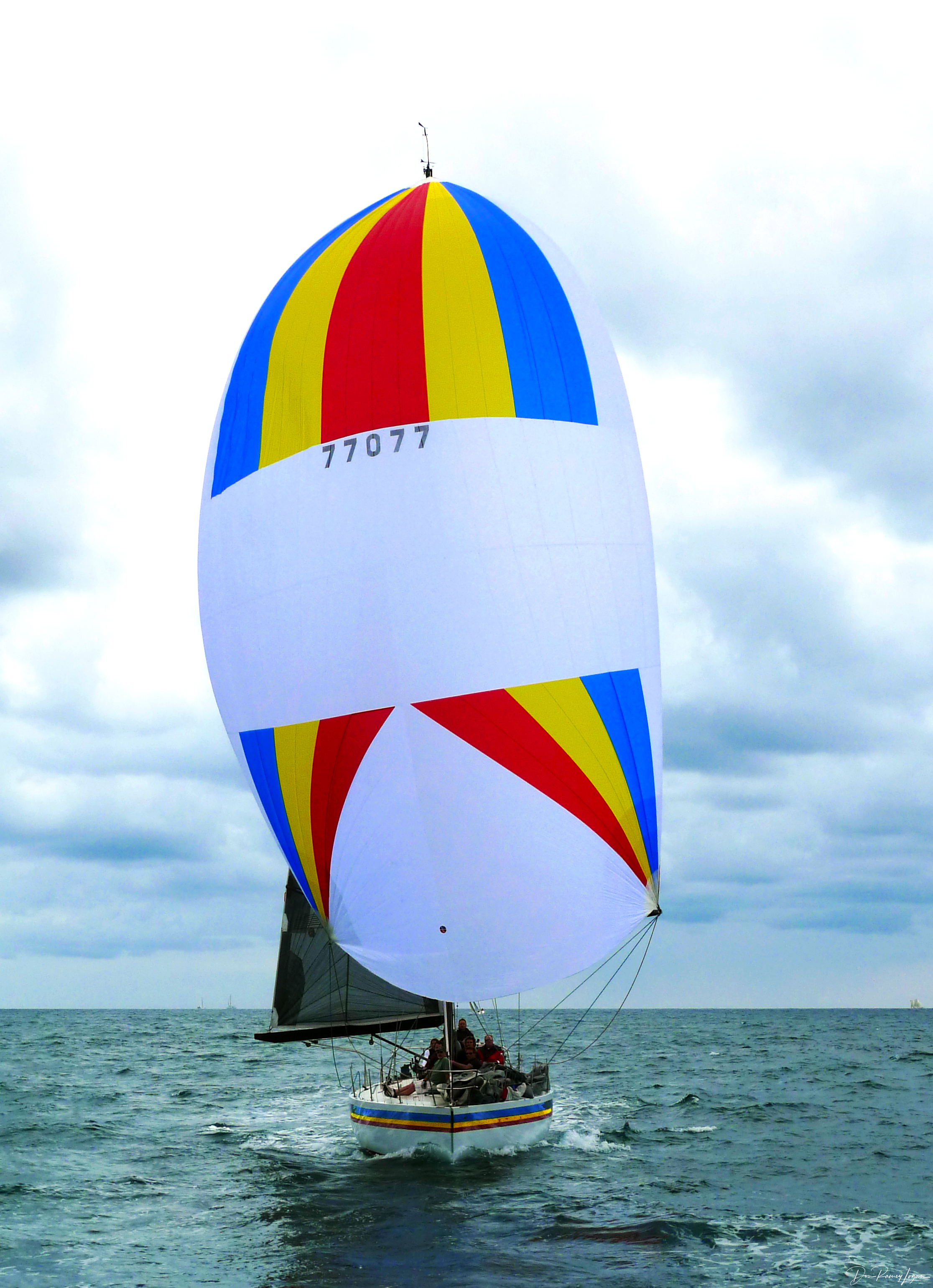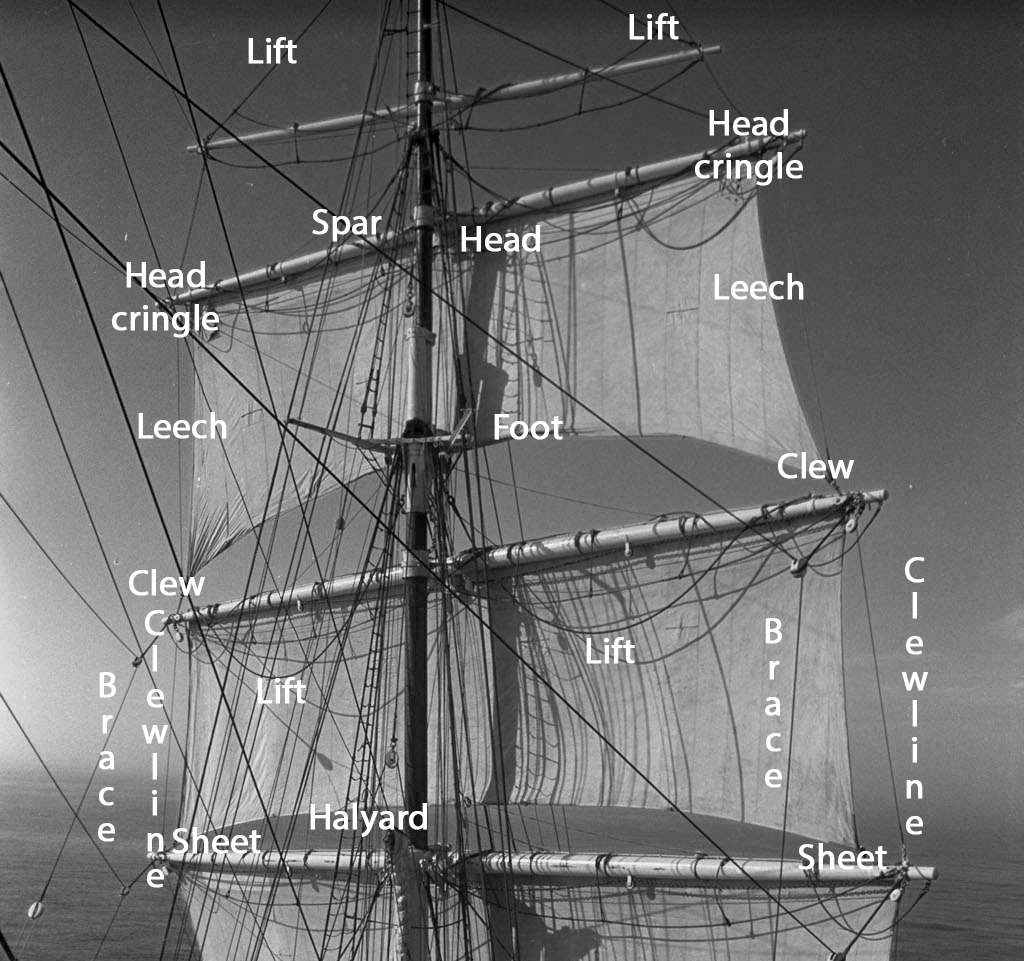|
Guy (sailing)
A guy (probably from Dutch ''gei'', " brail") is a line (rope) attached to and intended to control the end of a spar on a sailboat. On a modern sloop-rigged sailboat with a symmetric spinnaker, the spinnaker pole is the spar most commonly controlled by one or more guys. Types There are two primary types of guys used to control a spinnaker pole: *The afterguy, working guy, or simply guy and sometimes known as a brace is attached to the windward clew of the spinnaker, and runs through the jaws on the outboard end of the pole and back to the cockpit. The afterguy is used to rotate the outboard end of the pole around the mast in order to optimize the sail's effectiveness, depending on the direction of the wind. Because a spinnaker has two clews, there is always a second line identical to the afterguy attached to the leeward clew of the spinnaker. This is called the sheet and serves a slightly different function. When the boat jibe A jibe (US) or gybe (Britain) is ... [...More Info...] [...Related Items...] OR: [Wikipedia] [Google] [Baidu] |
Dutch Language
Dutch ( ) is a West Germanic languages, West Germanic language of the Indo-European language family, spoken by about 25 million people as a first language and 5 million as a second language and is the List of languages by total number of speakers, third most spoken Germanic language. In Europe, Dutch is the native language of most of the population of the Netherlands and Flanders (which includes 60% of the population of Belgium). "1% of the EU population claims to speak Dutch well enough in order to have a conversation." (page 153). Dutch was one of the official languages of South Africa until 1925, when it was replaced by Afrikaans, a separate but partially Mutual intelligibility, mutually intelligible daughter language of Dutch. Afrikaans, depending on the definition used, may be considered a sister language, spoken, to some degree, by at least 16 million people, mainly in South Africa and Namibia, and evolving from Cape Dutch dialects. In South America, Dutch is the native l ... [...More Info...] [...Related Items...] OR: [Wikipedia] [Google] [Baidu] |
Brail
Brails, in a sailing ship, are small lines used to haul in or up the edges ( leeches) or corners of sail A sail is a tensile structure, which is made from fabric or other membrane materials, that uses wind power to propel sailing craft, including sailing ships, sailboats, windsurfers, ice boats, and even sail-powered land vehicles. Sails may b ...s, before furling.. See entries for Brail ''n.'' and 2. ''pl. (Naut.)'', and Brail, ''v. t. (Naut.)''. On a ship rig, these brails are most often found on the mizzen sail. To haul and furl the sails, the command used in the early 18th century was ''hale up the brails'' or ''brail up the sails''. The word brail comes from Middle English ''brayle'', from Anglo-French ''braiel'' belt, strap, brail, alteration of Old French ''braiuel'' belt, probably ultimately from Latin ''braca'' pant. A brail net is a type of net incorporating brail lines on a small fishing net on a boat or castnet. A brail net used for casting is also refe ... [...More Info...] [...Related Items...] OR: [Wikipedia] [Google] [Baidu] |
Rope
A rope is a group of yarns, Plying, plies, fibres, or strands that are plying, twisted or braided together into a larger and stronger form. Ropes have high tensile strength and can be used for dragging and lifting. Rope is thicker and stronger than similarly constructed cord, String (structure), string, and twine. Construction Rope may be constructed of any long, stringy, fibrous material (e.g., rattan, a natural material), but generally is constructed of certain natural fibre, natural or synthetic fibre, synthetic fibres. Synthetic fibre ropes are significantly stronger than their natural fibre counterparts, they have a higher tensile strength, they are more resistant to rotting than ropes created from natural fibres, and they can be made to float on water. But synthetic ropes also possess certain disadvantages, including slipperiness, and some can be damaged more easily by UV light. Common natural fibres for rope are Manila hemp, hemp, linen, cotton, coir, jute, straw, an ... [...More Info...] [...Related Items...] OR: [Wikipedia] [Google] [Baidu] |
Spar (sailing)
A spar is a pole of wood, metal or lightweight materials such as carbon fibre used in the rigging of a sailing vessel to carry or support its sail. These include yards, booms, and masts, which serve both to deploy sail and resist compressive and bending forces, as well as the bowsprit and spinnaker pole. In larger vessels during the age of sail, spare spars could be roped together to provide a temporary surface known as a "spar deck". These served as jury-rigged repairs for permanent decks, or as an additional platform under which to shelter goods or crew. The term was also informally applied to areas of the forecastle The forecastle ( ; contracted as fo'c'sle or fo'c's'le) is the upper deck (ship), deck of a sailing ship forward of the foremast, or, historically, the forward part of a ship with the sailors' living quarters. Related to the latter meaning is t ... or quarterdeck where spare spars were stored by laying them flat against the existing decking. In the moder ... [...More Info...] [...Related Items...] OR: [Wikipedia] [Google] [Baidu] |
Sailboat
A sailboat or sailing boat is a boat propelled partly or entirely by sails and is smaller than a sailing ship. Distinctions in what constitutes a sailing boat and ship vary by region and maritime culture. Types Although sailboat terminology has varied across history, many terms have specific meanings in the context of modern yachting. A great number of sailboat-types may be distinguished by size, hull configuration, keel type, purpose, number and configuration of masts, and sail plan. Popular monohull designs include: Cutter The cutter is similar to a sloop with a single mast and mainsail, but generally carries the mast further aft to allow for two foresails, a jib and staysail, to be attached to the head stay and inner forestay, respectively. Once a common racing configuration, today it gives versatility to cruising boats, especially in allowing a small staysail to be flown from the inner stay in high winds. Catboat A catboat has a single mast mounted far forw ... [...More Info...] [...Related Items...] OR: [Wikipedia] [Google] [Baidu] |
Spinnaker
A spinnaker is a sail designed specifically for sailing off the wind on courses between a Point of sail#Reaching, reach (wind at 90° to the course) to Point of sail#Running downwind, downwind (course in the same direction as the wind). Spinnakers are constructed of lightweight fabric, usually nylon, and are often brightly colored. They may be designed to perform best as either a reaching or a running spinnaker, by the shaping of the panels and seams. They are attached at only three points and said to be ''flown''. Etymology Some dictionaries suggest that the origin of the word could be traced to the first boat to commonly fly a spinnaker, a yacht called ''Sphinx'', mispronounced as ''Spinx''. ''Spinnaker'' entry in The Concise Oxford Dictionary of English Etymology (1996). Oxford University PressAccording to encyclopedia.com Both retrieved on 20 July 2008. ''Sphinx'' first set her spinnaker in the Solent in 1865, and the first recorded use of the word was in 1866 in the Augu ... [...More Info...] [...Related Items...] OR: [Wikipedia] [Google] [Baidu] |
Spinnaker Pole
A spinnaker pole is a spar used in sailboats (both dinghies and yachts) to help support and control a variety of headsails, particularly the spinnaker. It is also used with other sails, such as genoas and jibs, when sailing downwind with no spinnaker hoisted, sometimes using a special light spinnaker pole called a whisker pole, possible since the load on the pole is very light on this point of sail. Rigging The spinnaker pole is rigged to run from the base of the mast, where there is a special fitting for attaching one end of the pole, out to windward over the side of the boat. There, one of the control lines of whichever sail it is to be used with is run through a fitting on the other end of the spinnaker pole. This allows for more precise control of the corner of the sail to which the line is attached. For a spinnaker, the line attached to the pole is the guy, or brace, and the corner is the tack. For other headsails, such as a jib, the line would be the sheet, atta ... [...More Info...] [...Related Items...] OR: [Wikipedia] [Google] [Baidu] |
Parts Of A Sail
Sail components include the features that define a sail's shape and function, plus its constituent parts from which it is manufactured. A sail may be classified in a variety of ways, including by its orientation to the vessel (e.g. ''fore-and-aft'') and its shape, (e.g. ''(a)symmetrical'', ''triangular'', ''quadrilateral'', etc.). Sails are typically constructed out of flexible material that is shaped by various means, while in use, to offer an appropriate airfoil, according to the strength and apparent direction of the wind. A variety of features and fittings allow the sail to be attached to lines and spars. Whereas conventional sails form an airfoil with one layer of fabric, wingsails comprise a structure that has material on both sides to form an airfoil—much like a wing placed vertically on the vessel—and are beyond the scope of this article. Classifications Sails may be classified as either ''triangular'', which describes sails that either come to one point of suspen ... [...More Info...] [...Related Items...] OR: [Wikipedia] [Google] [Baidu] |
Cockpit (sailing)
A cockpit is a name for the location of controls of a vessel. While traditionally an open well in the deck of a boat outside any deckhouse or cabin, in modern boats it may refer to an enclosed area. Smaller boats typically have an "aft cockpit", towards the stern of the boat, whereas larger vessels may have a "center cockpit" with greater protection from weather. On a recreational sailboat, the cockpit is considered the safest external location for crew. A bridge deck is a raised separation between an external cockpit and cabin or saloon, used to keep water from astern from entering from the cockpit, especially in following seas. History In the Royal Navy The Royal Navy (RN) is the naval warfare force of the United Kingdom. It is a component of His Majesty's Naval Service, and its officers hold their commissions from the King of the United Kingdom, King. Although warships were used by Kingdom ..., the term "cockpit" originally referred to the area where the coxswain was ... [...More Info...] [...Related Items...] OR: [Wikipedia] [Google] [Baidu] |
Leeward
In geography and seamanship, windward () and leeward () are directions relative to the wind. Windward is ''upwind'' from the point of reference, i.e., towards the direction from which the wind is coming; leeward is ''downwind'' from the point of reference, i.e., along the direction towards which the wind is going. The side of a ship that is towards the leeward is its "lee side". If the vessel is heeling under the pressure of crosswind, the lee side will be the "lower side". During the Age of Sail, the term ''weather'' was used as a synonym for ''windward'' in some contexts, as in the '' weather gage''. Since it captures rainfall, the windward side of a mountain tends to be wetter than the leeward side it blocks. The drier leeward area is said to be in a rain shadow. Origin The term "windward" has roots in both Low German and Old English. The word "lee", which means a place without wind, comes from the Old Norse "hle" for "cover" and has been used in marine navigation in G ... [...More Info...] [...Related Items...] OR: [Wikipedia] [Google] [Baidu] |





